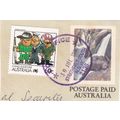Maidstone, Kent - Kits Coty House - megalith barrow - postcard 1907
- Condition : Used
- Dispatch : 2 Days
- Brand : None
- ID# : 102928866
- Quantity : 1 item
- Views : 379
- Location : United Kingdom

- Seller : justthebook (+1703)
- Barcode : None
- Start : Sat 20 Apr 2013 13:32:20 (EDT)
- Close : Run Until Sold
- Remain : Run Until Sold
Checks/Cheques
 for 1 item(s) edit
for 1 item(s) edit
Shipping Calculator
More Listings from This Seller view all
Seller's Description
- Postcard
- Picture / Image: Kits Coty House near Maidstone, Kent - a megalithic barrow
- Publisher: Invicta - 'Kent' series
- Postally used: yes
- Stamp: Edward VII half d. light green
- Postmark(s): Ash Jan 12 1907 cds
- Sent to: Mr. E. W. House, c/o Mrs. W. Wilson, 10 Richboro Road, Westgate on Sea, Kent
- Notes / condition:
Please ask if you need any other information and I will do the best I can to answer.
------------------------------------------------
Postage & Packing:
UK (incl. IOM, CI & BFPO): 99p
Europe: £1.60
Rest of world (inc. USA etc): £2.75
No additional charges for more than one postcard. You can buy as many postcards from me as you like and you will just pay the fee above once. (If buying postcards with other things such as books, please contact or wait for invoice before paying).
Payment Methods:
UK - PayPal, Cheque (from UK bank) or postal order
Outside UK: PayPal ONLY (unless otherwise stated) please. NO non-UK currency checks or money orders (sorry).
NOTE: All postcards are sent in brand new stiffened envelopes which I have bought for the task. These are specially made to protect postcards and you may be able to re-use them. In addition there are other costs to sending so the above charge is not just for the stamp!
I will give a full refund if you are not fully satisfied with the postcard.
----------------------------------------------
Text from the free encyclopedia WIKIPEDIA may appear below to give a little background information (internal links may not work) :
*************
Kit's Coty House or Kit's Coty is the name of the remains of a Neolithic chambered long barrow on Blue Bell Hill near Aylesford in the English county of Kent.
One of the Medway megaliths constructed in the vicinity of the River Medway, Kit's Coty House are located close to five other surviving chambered long barrows: the Coldrum Stones, Addington long barrow, Chestnuts long barrow, the Countless Stones and Coffin Stone.
The site is now under the ownership of non-departmental public body English Heritage, and is open to visitors all year round.
The Early Neolithic was a revolutionary period of British history. Beginning in the fifth millennium BCE, it saw a widespread change in lifestyle as the communities living in the British Isles adopted agriculture as their primary form of subsistence, abandoning the hunter-gatherer lifestyle that had characterised the preceding Mesolithic period.[1] Archaeologists have been unable to prove whether this adoption of farming was because of a new influx of migrants coming in from continental Europe or because the indigenous Mesolithic Britons came to adopt the agricultural practices of continental societies.[1] Between 4500 and 3800 BCE, all of the British Isles came to abandon its former Mesolithic hunter-gatherer lifestyle, to be replaced by the new agricultural subsistence of the Neolithic Age.[2]
There is archaeological evidence of violence and warfare in Early Neolithic Britain from such sites as West Kennet Long Barrow and Hambledon Hill, with some groups constructing fortifications to defend themselves from attackers.[3] Contemporary archaeologists have no direct proof of gender relations on the island at this time, although most believe that it was probably a male-dominated society, in keeping with all recorded societies that practice large-scale animal husbandry.
Across Western Europe, the Early Neolithic marked the first period in history when humans began to build monumental structures in the landscape.[4] These monumental structures were tombs designed for holding the remains of the dead, and were sometimes built out of timber, but many were instead constructed out of large stones, known as ""megaliths"".[4] Individuals were rarely buried alone in the Early Neolithic, instead being interned in collective burials with other members of their community.[5] The construction of these collective burial monumental tombs, sometimes wooden but often megalithic, began in continental Europe before being adopted by people in Britain.[6]
The Early Neolithic people of Britain placed a far greater emphasis on the ritualised burial of the dead than their Mesolithic forebears had done.[5] Many archaeologists have suggested that this is because Early Neolithic people were adherents of an ancestor cult that venerated the spirits of the dead, believing that they could intercede with the forces of nature for the benefit of their living descendants.[5][7] It has furthermore been suggested that Early Neolithic people entered into the tombs – which doubled as temples or shrines – to perform rituals that would honour the dead and ask for their assistance.[7]
The tombs themselves were typically located on prominent hills and slopes overlooking the surrounding landcape, particularly at the junction between different territories.[8] Archaeologist Caroline Malone noted that the tombs would have served as one of a variety of markers in the landscape that conveyed information on ""territory, political allegiance, ownership, and ancestors.""[9]
Archaeologists have differentiated these Early Neolithic tombs into a variety of different architectural styles, which were typically associated with specific regions within the British Isles.[7] Passage graves, characterised by their narrow passage made of large stones and one or multiple burial chambers covered in earth or stone, were predominantly located in northern Britain and southern and central Ireland. Alternately across northern Ireland and central Britain, long chambered mounds predominated, while in the east and south-east of Britain, earthen long barrows represented the dominant architectural trend.[10] These earthen long barrows were typically constructed of timber because building stone was scarce; archaeologist Aubrey Burl argued that these timber tombs might have been ""even more eye-catching"" than their stone coutnerparts, perhaps consisting of ""towering carved poles, flamboyantly painted"", but that evidence of such sculptures has not survived.[7]
type=printed postcards
theme=topographical: british
sub-theme=england
county/ country=kent
number of items=single
period=pre - 1914
postage condition=posted
Listing Information
| Listing Type | Gallery Listing |
| Listing ID# | 102928866 |
| Start Time | Sat 20 Apr 2013 13:32:20 (EDT) |
| Close Time | Run Until Sold |
| Starting Bid | Fixed Price (no bidding) |
| Item Condition | Used |
| Bids | 0 |
| Views | 379 |
| Dispatch Time | 2 Days |
| Quantity | 1 |
| Location | United Kingdom |
| Auto Extend | No |




















